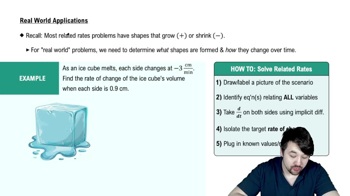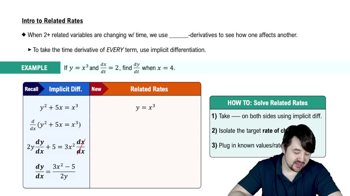Table of contents
- 0. Functions7h 52m
- Introduction to Functions16m
- Piecewise Functions10m
- Properties of Functions9m
- Common Functions1h 8m
- Transformations5m
- Combining Functions27m
- Exponent rules32m
- Exponential Functions28m
- Logarithmic Functions24m
- Properties of Logarithms34m
- Exponential & Logarithmic Equations35m
- Introduction to Trigonometric Functions38m
- Graphs of Trigonometric Functions44m
- Trigonometric Identities47m
- Inverse Trigonometric Functions48m
- 1. Limits and Continuity2h 2m
- 2. Intro to Derivatives1h 33m
- 3. Techniques of Differentiation3h 18m
- 4. Applications of Derivatives2h 38m
- 5. Graphical Applications of Derivatives6h 2m
- 6. Derivatives of Inverse, Exponential, & Logarithmic Functions2h 37m
- 7. Antiderivatives & Indefinite Integrals1h 26m
- 8. Definite Integrals3h 25m
4. Applications of Derivatives
Related Rates
Problem 1
Textbook Question
Explain the difference between the average rate of change and the instantaneous rate of change of a function f.
 Verified step by step guidance
Verified step by step guidance1
The average rate of change of a function f over an interval [a, b] is calculated using the formula: (f(b) - f(a)) / (b - a), which represents the slope of the secant line connecting the points (a, f(a)) and (b, f(b)).
In contrast, the instantaneous rate of change of a function f at a specific point x = c is defined as the limit of the average rate of change as the interval shrinks to zero, expressed mathematically as: lim (h -> 0) [(f(c + h) - f(c)) / h].
The average rate of change gives a general idea of how the function behaves over a larger interval, while the instantaneous rate of change provides a precise measure of the function's behavior at a single point.
The instantaneous rate of change is also interpreted as the derivative of the function f at the point c, denoted as f'(c), which represents the slope of the tangent line to the curve at that point.
Understanding the difference between these two rates of change is crucial in calculus, as it lays the foundation for concepts such as derivatives and the behavior of functions.
Recommended similar problem, with video answer:
 Verified Solution
Verified SolutionThis video solution was recommended by our tutors as helpful for the problem above
Video duration:
2mPlay a video:
Was this helpful?
Related Videos
Related Practice






